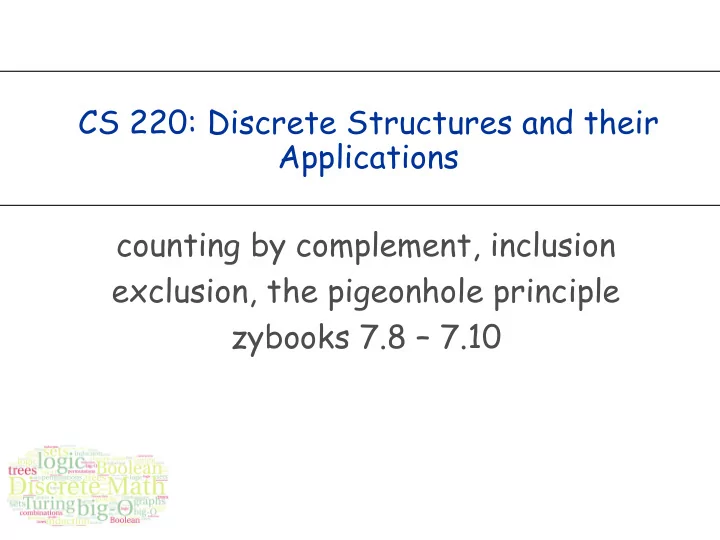

CS 220: Discrete Structures and their Applications counting by complement, inclusion exclusion, the pigeonhole principle zybooks 7.8 – 7.10
example problem How many 6-bit strings have at least one 0? You can count them directly: Number of 6-bit strings with at least one 0 = Number of 6-bit strings with one 0 + Number of 6-bit strings with two 0s + Number of 6-bit strings with three 0s + Number of 6-bit strings with four 0s + Number of 6-bit strings with five 0s + Number of 6-bit strings with six 0s
counting by complement How many 6-bit strings have at least one 0? Or you can use the complement rule: Number of 6-bit strings with at one 0 = Number of 6-bit strings - Number of 6-bit strings with no 0s = 2 6 – 1 The complement rule: Let P be a subset of a set S, then: | P | = | S | − | ¯ P |
example In how many ways can a photographer at a wedding arrange six people in a row, including the bride and groom, if ■ the bride must be next to the groom? ■ The bride is not next to the groom? ■ The bride is positioned somewhere to the left of the groom?
The inclusion exclusion principle A more general statement than the sum rule: |A È B| = |A| + |B| - |A Ç B|
Example How many numbers between 1 and 30 are divisible by 2 or 3?
The inclusion exclusion principle How many bit strings of length eight start with a 1 or end with 00? 1 - - - - - - - how many? - - - - - - 0 0 how many? if I add these, how many have I counted twice?
inclusion exclusion with three sets To compute the cardinality of the union of three sets: Let A, B and C be three finite sets, then |A ∪ B ∪ C| = |A| + |B| + |C| - |A ∩ B| - |B ∩ C| - |A ∩ C| + |A ∩ B ∩ C|
example a
the inclusion exclusion principle The general statement of the incusion-exclusion principle:
Some advice about counting Apply the multiplication rule if ■ The elements to be counted can be obtained through a multistep selection process. ■ Each step is performed in a fixed number of ways regardless of how preceding steps were performed. Apply the sum rule if ■ The set of elements to be counted can be broken up into disjoint subsets Apply the inclusion/exclusion rule if ■ It is simple to over-count and then to subtract duplicates
The pigeonhole principle If k is a positive integer and k+1 or more objects are placed into k boxes, then there is at least one box containing two or more objects. Image: http://en.wikipedia.org/wiki/File:TooManyPigeons.jpg
Examples In a group of 367 people, there must be at least two with the same birthday A drawer contains a dozen brown socks and a dozen black socks, all unmatched. A guy takes socks out at random in the dark. ■ How many socks must he take out to be sure that he has at least two socks of the same color? A) 13 B) 3 C) 12
Examples In a group of 367 people, there must be at least two with the same birthday A drawer contains a dozen brown socks and a dozen black socks, all unmatched. A guy takes socks out at random in the dark. ■ How many socks must he take out to be sure that he has at least two socks of the same color? ■ How many socks must he take out to be sure that he has at least two black socks?
Examples Show that if five different digits between 1 and 8 are selected, there must be at least one pair of these with a sum equal to 9. ask yourself: what are the pigeon holes? what are the pigeons?
Recommend
More recommend